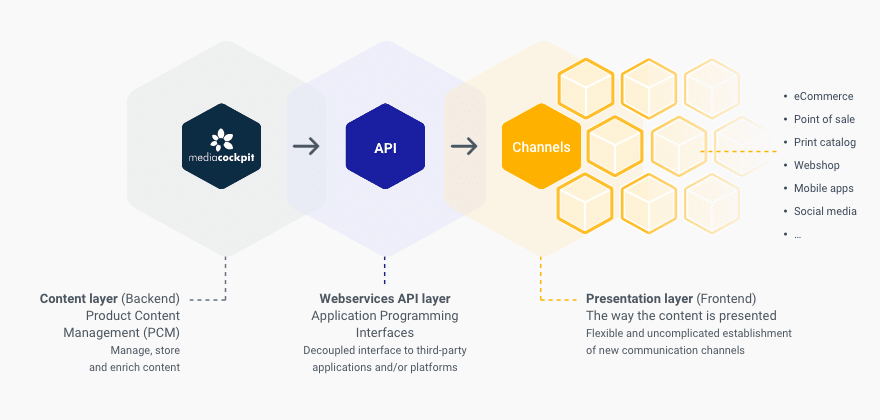Blog
How to efficiently manage and leverage media content

Digitization has contributed to the fact that today’s consumers are flooded with product offers and brand messages more than ever before. The more difficult it is for individual suppliers to stand out from the mass of offers and messages. Yet manufacturer brands and retailers have long since discovered that the use of media content is an excellent way to draw consumers’ attention to their own brand and products, as well as to satisfy their need for information and entertainment, setting positive impulses that mark the beginning of a buyer journey or even long-term brand loyalty.
However, in view of the large number of target groups and the increasing number of communication channels and sales opportunities, such impulses require an enormous amount of media content in a wide variety of variants and formats, making it difficult to keep the associated processes efficient. More and more companies are turning to a DAM system to help them handle their assets. In this blog article, you will learn about the benefits and use cases of a Digital Asset Management (DAM) software.
What is a DAM-System?
The abbreviation DAM stands for Digital Asset Management and describes the discipline of managing, preparing and distributing digital content such as image, audio, video or graphics files. A DAM system is the corresponding software product. The ultimate goal of a DAM system is to optimize all workflows around digital asset management by centralizing and standardizing the management of assets and replacing and automating non-scalable like manual processes. For a more detailed overview and the capabilites of a DAM Software, read more here.

Functions and technical features
The basic functions of a DAM software include the standardized import, structured organization, and channel-specific export of digital content. DAM acts as data hubs and encompass the entire lifecycle of a media asset, from acquisition or creation to archiving and output to a wide variety of channels – ultimately enabling immediate content publication with a minimum of resources and without technical hurdles.
DAM systems are basically structured like archives that store a company’s media asset inventory in a central location. Keywording is used to ensure that the archived assets are not lost and can be retrieved and monetized repeatedly via a search function. This is where the so-called metadata comes into play. This is data that contains content-related, technical or usage-related information, can be evaluated by machine and provides structure and transparency in the system.
The creation of digital content often involves many different employees as well as external parties, meaning the efficiency of the creative processes essentially depends on their collaboration. DAM systems therefore typically offer the option of assigning user roles and dedicated permissions flexibly and in line with requirements. In addition, they store the imported files in a media-neutral manner so that they can be accessed and directly edited by anyone with authorization, regardless of the system.
In addition to creative tasks, digital content delivery also involves smaller, repetitive tasks that can consume an excessive amount of resources. These tasks include the cropping or formatting of images, as well as the aforementioned keywording. Modern DAM systems therefore offer special AI components that, for instance, already tag the assets during upload and automatically convert them into the required sizes and file formats in the course of distribution.
When it comes to product communication, DAM systems, which are the hub for managing and delivering digital content, and PIM systems, which do the same for product information, form an unbeatable team. A PIM keeps your product data standardized and structured, and provides your team with a golden record of communication elements that they can merge with the media content in the DAM to create any type of rich product content (product features, infographics, etc.). The latest generation DAM systems are therefore characterized by an open system architecture that makes it possible to combine these two types of systems and connect other product and communication-related solutions via API interfaces.
All these functions and technical features make a DAM system particularly interesting for product managers, marketing teams, sales and customer service – in other words, for all those who come into contact with media content as part of their day-to-day work and are dependent on meaningful organization and easy control of this content. In view of the increasing number of technologies, communication channels, and sales opportunities, it is advisable to rely on cloud-based headless DAM solutions that can be flexibly deployed and are highly scalable, providing the infrastructure for omnichannel publishing and long-term process efficiency.
Manage media assets efficiently and use them effectively – with mediasuite
mediasuite is the DAM solution from Bertsch Innovation that provides companies with a range of features and tools to efficiently manage and effectively deploy their media content – across their own website, online store, social media channels or print catalog. Like all Bertsch Innovation software solutions, mediasuite was designed to be headless and cloud-based, to ensure that the system will continue to optimally support your digital asset management processes and workflows in the future. In addition, the platform offers further benefits.

Easy to use
The best DAM solution is of no use if your employees do not enjoy working with it. The mediasuite user interface has been designed to be intuitive, so that even new employees can quickly get to grips with the solution. In addition, your employees can define individual views in mediasuite and use the search, filter and preview functions to retrieve, edit and use all the files they need in no time at all.
Smooth collaboration
Business partners, agencies or freelancers – the media universe of companies often involves many external parties in addition to the company’s own employees. To ensure that collaboration between all parties runs efficiently and smoothly, mediasuite comes with an integrated workflow and role and rights management, so that a targeted assignment of to-do lists as well as a role- or task-specific distribution of individual assets or entire structures is possible.
Maximum flexibility and scalability
The ability to remain flexible in response to market changes is a key success factor these days. mediasuite is therefore based on a generic data model that allows any number of interconnections and ensures that you can map the dynamics of your business world at any time. In addition, the solution follows a consistently integrative approach with an API-first architecture, so that it can be easily integrated into existing system landscapes and supplemented with additional systems, tools and channels.
After all, successful product and brand communication always requires both: media content and editorially prepared copy. For this reason, Bertsch Innovation also offers an all-encompassing product content management solution that closely integrates the disciplines of PIM and DAM and unites them in a uniform user interface. All product and communication-relevant processes can be controlled via one and the same platform, resulting in a positive impact on your time-to-market, but also on the quality of your rich product content and the satisfaction of your employees and customers.
Discover the software solutions from Bertsch Innovation and elevate your product and brand communication to a contemporary and sustainable level.
Accomplish more together
We believe in the value of collaboration and exchange. This applies both to our customer projects, from which we generate many valuable insights for our product development, and to our growing partner network, with an extensive range of which we support our customers in their digitization.


